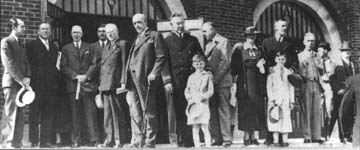 |
Special Report:
ARC's 60th Anniversary
Volume 10, Number 6
November/December 1995 |
NIDA's Addiction Research Center (ARC) 60th Anniversary
History of the Addiction Research Center
In 1935, what was to become the Addiction Research Center (ARC) was created as a small research unit at the U.S. Public Health Service Hospital in Lexington, Kentucky. The narcotics "farm" set out to develop and implement treatments for addicted people. The research unit was affiliated with a Federal prison in Lexington, treating prisoners and others who voluntarily admitted themselves to the facility.

Opening Day, May 15, 1935: The opening of this U.S. Public
Health Service Hospital in Lexington, Kentucky, also marked the genesis
of NIDA's Addiction Research Center, which started as a small research
unit at the hospital.
In addition to treating people dependent on drugs, the Center conducted pioneering studies into the nature of the addictive process and sought to develop a painkiller that would be effective but that would not possess the addictive properties of morphine and other opioids. At Lexington, the ARC became the unparalleled focus of addiction research and the training ground for scores of researchers who became leaders in the emerging specialty of drug abuse research. ARC scientists conducted ground-breaking opiate research and studies that established definitive animal models of addiction still widely used as tools for research today.
The many achievements and contributions of ARC researchers include:
- Advancing the use of methadone to treat heroin addiction.
- Helping explain why so many addicted people undergo repeated relapses to drug abuse even after successful treatment.
- Demonstrating that drug dependence is not limited to opiates and extends to other drugs of abuse.
- Helping find and study multiple opioid receptors, the binding sites in the nervous system where heroin and other opiates unleash their effects.
- Recognizing the significance of opioid antagonists for opiate abuse treatment and research as well as developing an opioid antagonist as a lifesaving antidote for heroin overdoses.
- Developing abuse liability studies and criteria to help scientists determine whether new pharmaceutical products might bear potential for treating addiction and abuse.
- Profiling the physiological and psychological effects of classes of drugs-including sedatives, hypnotics, hallucinogens, and marijuana-to provide basic tools for continuing research on and evaluation of drugs.
The ARC was designated as NIDA's intramural research program when the Institute was created in 1973. The ARC's clinical research unit was relocated to Baltimore in 1979, and the basic science unit followed in 1984.
From NIDA NOTES, November/December, 1995
[NIDA Home Page][NIDA NOTES Index][1995 Archive Index]
|